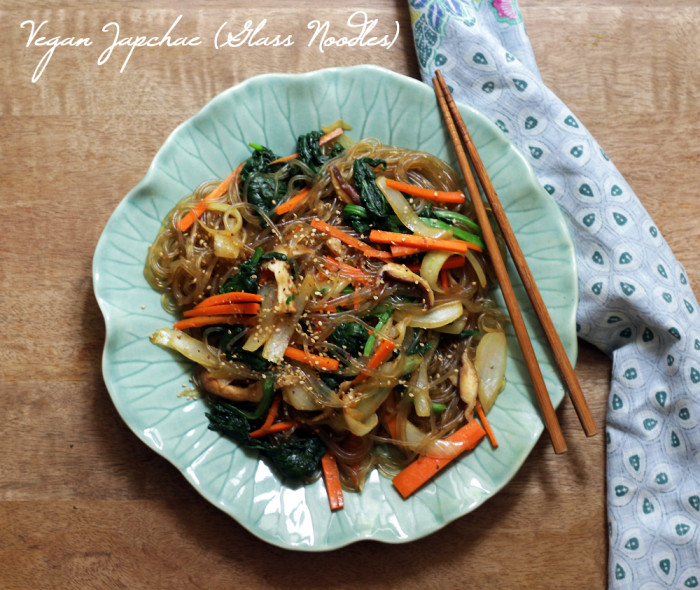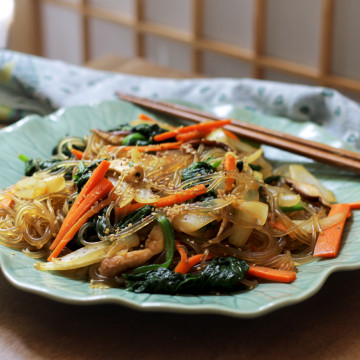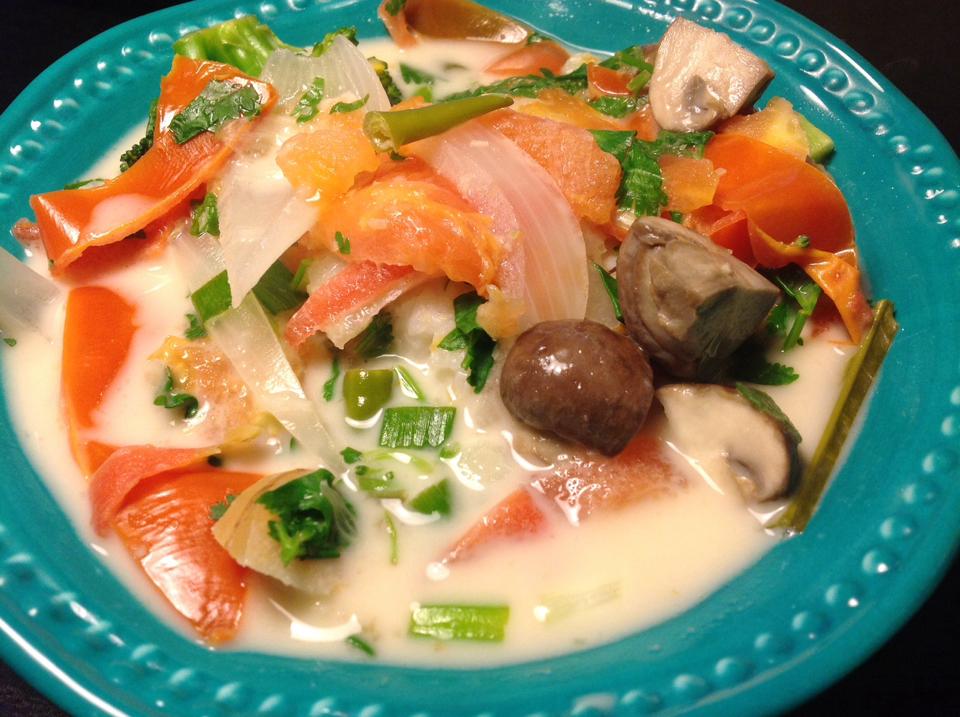Growing up, japchae was my favorite dish ever. Japchae is a go-to dish for holidays and special occasions, like having people over for dinner. But what made japchae of my childhood so amazing was that my mom would give each of us kids a warm bowl as soon as it was done, so we wouldn’t have to wait in agony until dinnertime. She never pushed us away from special food for company, but made us feel as though we were #1–which we were. 🙂
Craving japchae of my childhood, I asked my mom how to make it. As usual, her directions were both enthusiastic and somewhat ambiguous: “Boil until well and done” and “plenty of soy sauce and some sesame oil.” No respectable Korean mom would ever use (or own?) measuring cups or spoons. The less you use tools and more intuitive you are, the better. Mom’s one piece of concrete advice was that you can’t ever cook the vegetables together, because each one cooks at a different rate and one can color the other.
The vegan japchae I made following her directions omitted the traditional non-vegan ingredients, but otherwise tasted exactly like Mom’s–sweet and salty, springy sweet potato noodles with 4 color vegetables (mushroom-brown, onion-white, spinach-green, carrot-orange). These are the most traditional vegetables, but you could also add your favorite veggies. The rule of thumb with Korean food is to be mindful of the colors represented; red bell peppers would be a nice addition with its vibrant hue.
Vegan Japchae (Korean Glass Noodles)
Serves 3
6 oz dry sweet potato vermicelli noodles (look for these in Asian grocery stores; may be called “vermicelli” or “sweet potato” or “glass” noodles; ingredients should be just sweet potato and water)
5 tbsp soy sauce
2 tbsp sugar
1 tbsp sesame oil
about 1.5 tbsp olive oil
1 medium carrot, julienned
1 bunch spinach, washed, drained, and trimmed
8 oz fresh shiitake mushrooms or about 10 pieces dry shiitake mushrooms, soaked in warm water until reconstituted, sliced
1 onion, sliced
toasted sesame seeds for garnish
1. In a steamer, steam the spinach for about 1 minute or until vivid green. Remove from steamer and rinse immediately in cold water. Drain and gently squeeze out all the water from spinach. Set aside.
2. In a wok or a large saute pan, heat 1 tbsp olive oil over medium heat. When it starts to bubble a bit, add onion slices and cook, stirring occasionally, for 7 minutes, or until translucent and soft. Remove from pan and set aside.
3. In the same pan, add about a tsp of oil and saute carrots for 2-3 minutes until soft and cooked through. (If sticking, just splash a tablespoon of water to cook with steam). Remove from pan and set aside.
4. In the same pan, add another tsp of oil (if needed) and cook the mushrooms for about 2 minutes until cooked. Turn off the heat.
5. Boil plenty of water in a large pot. When it is boiling, add noodles and cook for 5 minutes. Drain and immediately rinse in cold water to prevent sticking and overcooking. Drain thoroughly and set aside. *It’s important that you try to remove all the water as much as possible so keep it resting in the colander, over a pot.
6. In a small bowl, mix the soy sauce, sesame oil, and sugar. Add all the cooked vegetables and noodles back to the pan and pour the soy sauce mixture over the noodles. Use chopsticks to distribute the sauce evenly over the noodles. Turn on the heat to medium and cook for a few more minutes while tossing. Taste and adjust seasoning with salt, if needed. Remove from heat and garnish with toasted sesame seeds. Plate, and enjoy! It’s best warm, straight from the pan.
More vegan Asian food: Rice Noodle Soup in coconut kale broth
Love this article? Keep up-to-date on the latest from Peaceful Dumpling: Subscribe to our Newsletter!
__
Photo: Peaceful Dumpling







